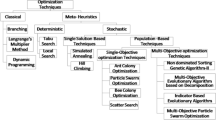Abstract
A fast algorithm is proposed to solve a kind of high complexity multi-objective problems in this paper. It takes advantages of both the orthogonal design method to search evenly, and the statistical optimal method to speed up the computation. It is very suitable for solving high complexity problems, and quickly yields solutions which converge to the Pareto-optimal set with high precision and uniform distribution. Some complicated multi-objective problems are solved by the algorithm and the results show that the algorithm is not only fast but also superior to other MOGAS and MOEAs, such as the currently efficient algorithm SPEA, in terms of the precision, quantity and distribution of solutions.
Similar content being viewed by others
References
Bock T, Fogel D B, Michalewicz Z.Handbook of Evolutionary Computation. Bristol (UK): Institute of Physics Publishing, 1997.
Schaffer J D.Multiple Objective Optimization with Vector Evaluated Genetic Algorithms: [Ph. D Thesis], Vanderbilt: Vanderbilt University, 1984.
Schaffer J D. Multiple Objective Optimization with Vector E-valuated Genetic Algorithms. In: J J Grefenstette Ed.Proceedings of an International Conference on Genetic Algorithms and Their Applications. Pitts-burgh, PA, 1985. 93–100. Sponsored by Texas Instruments and U. S. Navy Center for Applied Research in Artificial Intelligence (NCAR-AI).
Hajela P C, Lin Y. Genetic Search Strategies in Multicriteri-on Optimal Design.Structural Optimization, 1992,4: 99–107.
Fonseca C M, Fleming P J. Genetic Algorithms for Multiob-jective Optimization: Formulation, discussion and generalization. In: S Forrest edEd.Proceedings of the Fifth International Conference on Genetic Algorithms, San Mateo, California: Morgan Kaufmann, 1993. 416–423.
Horn J, Nafpliotis N. Multiobjective Optimization Using the Niched Pareto Genetic algorithm. IlliGAL Report 93005, Illinois Genetic Algorithms Laboratory, University of Illinois, Urbana, Champaign. 1993.
Horn J, Nafpliotis N, Goldberg D E. A Niched Pareto Genetic Algorithm for Multiobjective Optimization.Proceedings of the First IEEE Conference on Evolutionary Computation, IEEE World Congress on Computational Computation, 1994,1: 82–87.
Srinivas N, Deb K. Multiobjective Optimization Using Non-dominated Sorting in Genetic Algorithms.Evolutionary Computation, 1994,2(3): 221–248.
Zitzler E.Evolutionary Algorithms for Multiobjective Optimization: Methods and Applications: [Ph. D Thesis], Zurich Switzerland; Swiss Federal Institute of Technology (ETH). 1999.
Deb K, Agrawal S, Pratap A,et al. A Fast Elitist Non-dominated Sorting Genetic Algorithm for Multi-objective Optimization: NSGAI1. In: M. S.et al. Ed. Parallel Problem Solving from Nature-PPSN VI, Berlin; Springer. 2000. 849–858.
Zitzler E, Laumanns, M, Thiele L. SPEA2; Improving the Strength Pareto Evolutionary Algorithm. TIK-Report 103. ETH Zentrum, Gloriastrasse 35, CH-8092 Zurich, Switzerland. 2001.
Purshouse R C, Fleming P J.The Multi-objective Genetic Algorithm Applied to Benchmark Problems—An Analysis. Research Report No. 796. Department of Automatic Control and Systems, Engineering University of Sheffield, Sheffield, S1 3JD, UK. 2001.
Tiwari A, Roy R. Generalised Regression GA for Handling Inseparable Function Interaction: Algorithm and Applications.Proceedings of the Seventh International Conference on Parallel Problem Solving from Nature. ( PPSN VII). Granada, Spain,2002.
Montgomery D C.Design and Analysis of Experiments. 3rd ed. New York: Wiley, 1991.
Deb K, Agrawal S, Pratap A,et al. A Fast and Elitist Multiobjective Genetic Algorithm: NSGAII. Technical Report 200001, Indian Institute of Technology, Kanpur: Danpur Genetic Algorithms Laboratory (KanGAL). 2000.
Author information
Authors and Affiliations
Corresponding author
Additional information
Foundation item: Supported by the National Natural Science Foundation of China (60204001, 70071042, 60073043, 60133010) and Youth Chengguang Project of Science and Technology of Wuhan City (20025001002).
Biography: Zeng San-you ( 1963-), male, Associate professor, research direction: evolutionary computing, parallel computing
Rights and permissions
About this article
Cite this article
San-you, Z., Li-xin, D. & Li-shan, K. Solving a kind of high complexity multi-objective problems by a fast algorithm. Wuhan Univ. J. of Nat. Sci. 8, 183–188 (2003). https://doi.org/10.1007/BF02899476
Received:
Issue Date:
DOI: https://doi.org/10.1007/BF02899476




